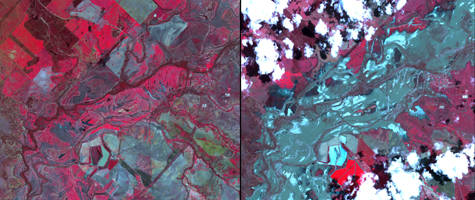
Figure 1
Click on the image for larger versionOn Jan. 21, 2011, the Advanced Spaceborne Thermal Emission and Reflection Radiometer (ASTER) instrument on NASA's Terra spacecraft captured this image of the flooding along the Balonne River and the town of Surat in southeastern Queensland, Australia. Torrential rains in northeastern Australia caused rivers to overflow their banks and flood much of the surrounding agricultural lands and small towns in the flood plain. While the peak of the flood was 10 days earlier, many residents were waiting for flood waters to recede. Vegetation is depicted in various shades of red, and buildings and clouds are white. Wet fields and land appear blue and dark blue-gray. For comparison, an image acquired one year ago (Jan. 11, 2010) is shown in Figure 1. The images are located at 27.1 degrees south latitude, 149.1 degrees east longitude. They cover an area of 15 by 17.8 kilometers (9.3 by 11 miles).
With its 14 spectral bands from the visible to the thermal infrared wavelength region and its high spatial resolution of 15 to 90 meters (about 50 to 300 feet), ASTER images Earth to map and monitor the changing surface of our planet. ASTER is one of five Earth-observing instruments launched Dec. 18, 1999, on Terra. The instrument was built by Japan's Ministry of Economy, Trade and Industry. A joint U.S./Japan science team is responsible for validation and calibration of the instrument and data products.
The broad spectral coverage and high spectral resolution of ASTER provides scientists in numerous disciplines with critical information for surface mapping and monitoring of dynamic conditions and temporal change. Example applications are: monitoring glacial advances and retreats; monitoring potentially active volcanoes; identifying crop stress; determining cloud morphology and physical properties; wetlands evaluation; thermal pollution monitoring; coral reef degradation; surface temperature mapping of soils and geology; and measuring surface heat balance.
The U.S. science team is located at NASA's Jet Propulsion Laboratory, Pasadena, Calif. The Terra mission is part of NASA's Science Mission Directorate, Washington, D.C.
More information about ASTER is available at http://asterweb.jpl.nasa.gov/.

